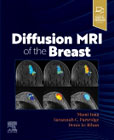
Diffusion weighted imaging (DWI) is a key emerging imaging modality for the management of patients with possible breast lesions, and Diffusion MRI of the Breast is the first book to focus on all aspects of DWI in today's practice. It covers the knowledge necessary to undertake clinical breast DWI, with a thorough review of how DWI is currently used as a breast imaging modality and how breast lesions appear on DWI. Expert clinicians and physicists from around the world share their knowledge and expertise on everything from technical requirements and image analysis to clinical applications of DWI (diagnosis, prognosis, treatment monitoring) with case examples, and upcoming developments in the field (radiomics, AI). INDICE: Introduction A- Basics of breast diffusion MRI - General principles and challenges of diffusion MRI (Le Bihan, Iima, Partridge) This section will provide the physical basis of Diffusion MRI, give the key concepts necessary to understand and use DWI in clinical practice B- Breast Clinical Applications - Overview of conventional breast imaging (MMG, US, MRI except DWI) (Mann and/or Kuhl) This chapter will give a general overview of the field of breast imaging, with pros and cons, to help positioning DWI among all other approaches - Overview of breast DWI: Diagnosis of suspicious lesions using DWI in combination with standard MRI (20 pages) (Baltzer, Clauser, Gilbert) This chapter will review how DWI is currently used as a breast imaging modality and how breast lesions appear with DWI - Biomarkers, prognosis and prediction factors (10 pages) (Iima, Moy) This chapter will explain how DWI could be specifically used to provide information on prognosis and prediction factors (eg Her, Pg, ER, Ki67 receptors expression) and help lesion management - Disease and treatment monitoring (10 pages) (Partridge, Hylton, Li) This chapter will provide guidance on how DWI can be used to manage breast lesions, from diagnosis to treatment monitoring, using examples for most common types of lesions - Diffusion MRI as a stand-alone unenhanced breast imaging approach and screening (10 pages) (Amornsiripanitch, Hee Jung Shin, Partridge) This chapter will foresee how DWI could be used as a stand-alone approach (without DCE): patient population, technical requirement - DWI and breast physiology status (menstrual cycle, pregnancy, lactation) (10 pages) (Iima, Nissan) This chapter will review how changes in hormonal context and physiology may affect appearance of DWI normal breast tissues and lesions C- Challenges and Advanced Techniques - IVIM/perfusion Non-Gaussian diffusion (20 pages) (Sigmund, Iima, Le Bihan) This chapter will show how tissue microcirculation (perfusion) can be obtained from DWI without the need for tracers or contrast agent, explain why boosting sensitivity to diffusion provides added contrast and information on tissue microstructure, and how to combine both approaches in a clinical setting - DTI (20 pages) (Sigmund, Partridge) This chapter will explain how Diffusion Tensor Imaging could potentially reveal oriented features in the breast (eg ducts) and how lesions might modify them - Tissue characterization, radiomics, Artificial Intelligence, multiparametric imaging and integration of diffusion MRI to BIRADS (20 pages) (Pinker, Morris) This chapter will explain how DWI could be combined to other advanced breast imaging approaches to provide higher sensitivity, specificity and prognosis - Novel/Alternative Acquisition Techniques - (20 pages) o DWIBS (Takahara) o MS-EPI, RS-EPI, SMS, RSI, etc - (Hargreaves) Those short chapters will provide glances at novel or alternative methods to perform DWI with specific focus for breast applications D- Let us get practical - Clinical interpretation of diffusion MRI, ROI assessment, common errors, pitfalls and artifacts, challenges in acquisition (20 pages) (Gilbert, Patterson) This chapter will provide guidance on the interpretation of DWI in the breast, qualitatively and quantitatively, showing how common errors can be avoided and artifacts corrected - Quality control, standardization, test-objects (20 pages) (Chenevert, Newitt, Malyarenko, Keenan) This chapter will provide guidance on how to optimize DWI protocols, verify and control settings to obtain accurate and reproducible results
- ISBN: 978-0-323-79702-3
- Editorial: Elsevier
- Encuadernacion: Rústica
- Páginas: 260
- Fecha Publicación: 01/09/2022
- Nº Volúmenes: 1
- Idioma: Inglés
